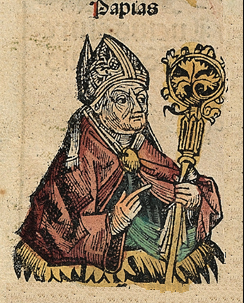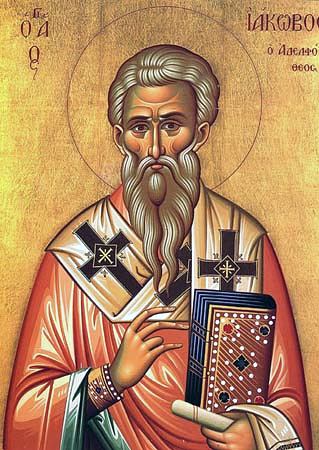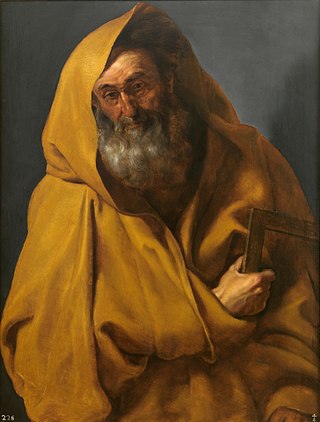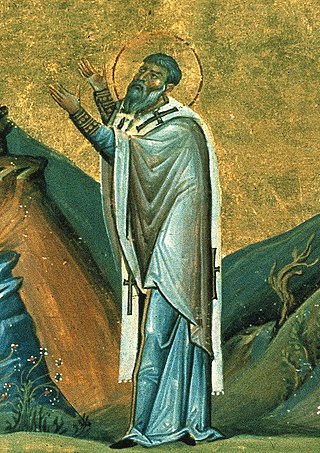
Matthew the Apostle is named in the New Testament as one of the twelve apostles of Jesus. According to Christian traditions, he was also one of the four Evangelists as author of the Gospel of Matthew, and thus is also known as Matthew the Evangelist.

Papias was a Greek Apostolic Father, Bishop of Hierapolis, and author who lived c. 60 – c. 130 AD He wrote the Exposition of the Sayings of the Lord in five books. This work, which is lost apart from brief excerpts in the works of Irenaeus of Lyons and Eusebius of Caesarea, is an important early source on Christian oral tradition and especially on the origins of the canonical Gospels.

James the Less is a figure of early Christianity. He is also called "the Minor", "the Little", "the Lesser", or "the Younger", according to translation, James is styled "the Less" to distinguish him from the Apostle James the Great with "Less" meaning younger or shorter, rather than less important. James the Great was the brother of John the Apostle.

James the Just, or a variation of James, brother of the Lord, was, according to the New Testament, a brother of Jesus. He was the first leader of the Jerusalem Church of the Apostolic Age. Traditionally, it is believed he was martyred either in AD 62 by being stoned to death on the order of High Priest Ananus ben Ananus, or in AD 69 by being thrown off the pinnacle of the Temple by scribes and Pharisees and then clubbed to death. James, Joses, Simon, and Judas are mentioned as the brothers of Jesus as well as two or more unnamed sisters.

The brothers of Jesus or the adelphoi are named in the New Testament as James, Joses, Simon, Jude, and unnamed sisters are mentioned in Mark and Matthew. They may have been: (1) sons of Mary, the mother of Jesus, and Joseph; (2) sons of Joseph by a former marriage; or (3) sons of Mary of Clopas, named in Mark 15:40 as the "mother of James and Joses", who has been identified as either the sister of Mary, the mother of Jesus, or a sister-in-law to Joseph.

Cleopas, also spelled Cleophas, was a figure of early Christianity, one of the two disciples who encountered Jesus during the Road to Emmaus appearance in Luke 24:13–32.

Jude was one of the Twelve Apostles of Jesus according to the New Testament. He is generally identified as Thaddeus and is also variously called Judas Thaddaeus, Jude Thaddaeus, Jude of James, or Lebbaeus. He is sometimes identified with Jude, the brother of Jesus, but is clearly distinguished from Judas Iscariot, the disciple who betrayed Jesus prior to his crucifixion. Catholic writer Michal Hunt suggests that Judas Thaddaeus became known as Jude after early translators of the New Testament from Greek into English sought to distinguish him from Judas Iscariot and subsequently abbreviated his forename. Most versions of the New Testament in languages other than English and French refer to Judas and Jude by the same name.
Clopas is a figure of early Christianity. The name appears in the New Testament, specifically in John 19:25:
Near the cross of Jesus stood his mother, his mother's sister, Mary the wife of Clopas, and Mary Magdalene.
The term logia, plural of logion, is used variously in ancient writings and modern scholarship in reference to communications of divine origin. In pagan contexts, the principal meaning was "oracles", while Jewish and Christian writings used logia in reference especially to "the divinely inspired Scriptures". A famous and much-debated occurrence of the term is in the account by Papias of Hierapolis on the origins of the canonical Gospels. Since the 19th century, New Testament scholarship has tended to reserve the term logion for a divine saying, especially one spoken by Jesus, in contrast to narrative, and to call a collection of such sayings, as exemplified by the Gospel of Thomas, logia.
In the Acts of the Apostles, Joseph Barsabbas was one of two candidates qualified to be chosen for the office of apostle after Judas Iscariot lost his apostleship when he betrayed Jesus and committed suicide. After the casting of lots he was not chosen, the lot instead favoring St. Matthias to be numbered with the remaining eleven apostles.

According to the Gospel of John, Mary of Clopas was one of the women present at the crucifixion of Jesus and bringing supplies for his funeral. The expression Mary of Clopas in the Greek text is ambiguous as to whether Mary was the daughter or wife of Clopas, but exegesis has commonly favoured the reading "wife of Clopas". Hegesippus identified Clopas as a brother of Joseph. In the latest official edition of the Roman Martyrology of the Catholic Church she is commemorated with Salome on April 24th.

Jude is one of the "brothers" of Jesus (Greek: ἀδελφοί, romanized: adelphoi, lit. 'brethren') according to the New Testament. He is traditionally identified as the author of the Epistle of Jude, a short epistle which is reckoned among the seven general epistles of the New Testament—placed after Paul's epistles and before the Book of Revelation—and considered canonical by Christians. Catholics and Eastern Orthodox Christians believe this Jude is the same person as Jude the Apostle; Catholics hold that Jude was a cousin, but not literally a brother of Jesus, while the Eastern Orthodox hold that Jude is St. Joseph's son from a previous marriage.

Matthew 10:3 is the third verse in the tenth chapter of the Gospel of Matthew in the New Testament.

James, son of Alphaeus was one of the Twelve Apostles of Jesus, appearing under this name in all three of the Synoptic Gospels' lists of the apostles. He is generally identified with James the Less and commonly known by that name in church tradition. He is also labelled "the Minor", "the Little", "the Lesser", or "the Younger", according to translation. He is distinct from James, son of Zebedee and in some interpretations also from James, brother of Jesus. He appears only four times in the New Testament, each time in a list of the twelve apostles.

Mary, mother of James is identified in the synoptic gospels as one of the women who went to Jesus' tomb after he was buried. Mark 16:1 and Luke 24:10 refer to "Mary the mother of James" as one of the Myrrhbearers, the women who went to the tomb of Jesus.

Abercius of Hieropolis was a Christian clergyman from Hierapolis at the time of Roman emperor Marcus Aurelius. He is maybe identical to an author who is called Avircius Marcellus in later sources. It is generally considered – although not indisputable – that he was bishop of Hierapolis and as such the successor to Papias.

Simon is described in the New Testament as one of the "brothers" of Jesus.

The Hebrew Gospel hypothesis is that a lost gospel, written in Hebrew or Aramaic, predated the four canonical gospels. In the 18th and early 19th century several scholars suggested that a Hebrew proto-gospel was the main source or one of several sources for the canonical gospels. This theorizing would later give birth to the two source-hypothesis that views Q as a proto-gospel but believes this proto-gospel to have been written in Koine Greek. After the widespread scholarly acceptance of the two-source hypothesis, scholarly interest in the Hebrew gospel hypothesis dwindled. Modern variants of the Hebrew gospel hypothesis survive, but have not found favor with scholars as a whole.

In Christian theology and ecclesiology, the apostles, particularly the Twelve Apostles, were the primary disciples of Jesus according to the New Testament. During the life and ministry of Jesus in the 1st century AD, the apostles were his closest followers and became the primary teachers of the gospel message of Jesus. There is also an Eastern Christian tradition derived from the Gospel of Luke that there were seventy apostles during the time of Jesus' ministry.















